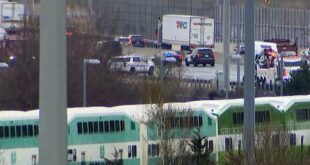Officer executed high-risk manoeuvre despite lack of training in technique

"Take the vehicle out."
Const. Heidi Marshall says that she had never heard a commanding officer give such an order in her 21 years of working in law enforcement.
Marshall was part of the RCMP team that chased down Myles Sanderson, 32, on Sept. 7, 2022, three days after he killed 11 people and wounded 17 others in and around the James Smith Cree Nation.
Testifying Tuesday at the public coroner's inquest into the circumstances around Sanderson's arrest and death, Marshall recalled the instructions given over the radio as officers began the pursuit of the killer who had stolen a white Chevy Avalanche from a rural property near Wakaw, northeast of Saskatoon: "Take the vehicle out."
Coroner's counsel Timothy Hawryluk asked Marshall what the order to "take the vehicle out" meant to her.
"Stop him," she replied, adding that it could be with words, weapons — or by using her RCMP Ford Explorer.
"I wasn't thinking about anything other than getting this person off the road, getting this vehicle off the road so no one else gets hurt," she testified.

Jurors at Myles Sanderson inquest hear from officer who forced killer's stolen truck into ditch
6 hours ago
Constable Heidi Marshall described chasing Myles Sanderson into oncoming traffic on a major Saskatchewan highway and the decision she made that ended the chase. Sanderson killed 11 people at James Smith Cree Nation and the neighbouring village of Weldon in September 2022. CBC's Dan Zakreski has the details.
Killer on the move
Sanderson had been the subject of one of the province's largest manhunts when he broke cover mid-afternoon on Sept. 7.
An earlier inquest heard how he had been hiding in a stand of trees near a rural property about 30 kilometres northeast of Wakaw, Sask., a small town 105 kilometres northeast of Saskatoon.
CBC News spoke with a man who said Myles broke into his mother's rural home that day around 2 p.m. CST.
CBC agreed not to name the woman or her son because she was the victim of an alleged crime.
The son said when his mother, a widow, saw Sanderson walk up to her front door, which was locked, she ran into the bathroom adjoining her bedroom, locking both the bedroom and bathroom doors.
She had her cellphone and was trying to call police when Myles smashed the front, bedroom and bathroom doors.
Myles was armed with a knife, the son said, but told his mother that he wouldn't hurt her.
Myles took the keys to the woman's Avalanche, along with her cellphone, cigarettes, water and a Pepsi, the son said. Myles asked the woman to go with him, according to her son, but she refused, believing that he would kill her.
When Myles left the property, the woman called a relative using a landline who then called RCMP, the son said, and the chase was on.
Catastrophic possibilities
Jurors at the inquest heard how Sanderson drove west, past Wakaw on Highway 312, with various RCMP units converging and joining the chase.
Marshall testified that she spotted the stolen truck as it turned south onto the north-bound lanes of Highway 11, the major four-lane highway that runs through the centre of the province, at speeds approaching 160 km/h.
Det. Sgt. Ken Kane presented the results of the independent investigation by the Saskatoon Police Service into the RCMP's actions that day. He tried to convey to jurors the potential for catastrophe when Sanderson turned the wrong way onto Highway 11.
Imagine, he said, a civilian driving north that afternoon. It was a clear, dry day and they would likely be driving at least the posted speed limit, 110 km/h. They probably would have seen flashing emergency lights in the southbound lanes across the grassy median as pursuing officers paralleled Sanderson.
Within 10 seconds, they would have seen the stolen Avalanche flying at them at 160 km/h. In a 10-kilometre stretch, he said, Sanderson forced 40 different vehicles either into the ditch or to veer out of the way, with Marshall on his tail.
As she engaged in the perilous chase, Marshall allowed herself a moment to reflect on the stakes.
"I have two little kids at home and when we were southbound at those high speeds the thing that I remember at the time was [thinking] 'What's going to happen to my kids? Am I going to leave them without a mom?'" she testified between sobs. "The one thing in my life that I always wanted to be was a mom, so I did not want to leave my family without a mom."
However, she added, "that quickly fleeted out of my mind, I didn't really have an opportunity to think of it for too long."
Marshall testified she had to push her Ford Explorer "to the top of its physical capabilities" to keep pace. She knew that another officer in a Chevy Tahoe SUV had already rear-ended the centre of Sanderson's truck, which served only to push it forward.
Marshall knew she had to do something different.
High speed gamble
After 10 kilometres driving into oncoming traffic, Sanderson abruptly crossed the median and joined traffic heading in the correct lane toward Saskatoon.
This decision, said Det. Sgt. Kane, gave Marshall the opportunity to make the "tactically sound" decision to follow Sanderson across the median, deliberately hit the stolen truck and force it into the ditch.
The PIT (precision immobilization technique) manoeuvre requires the pursuit vehicle to nudge the rear corner of the vehicle being chased, causing it to spin to a stop.
It is considered a high-risk move at 80 km/h. Marshall, who had never been trained in the technique, was going to attempt it while driving at more than twice that speed.
Kane testified he's watched the dashcam video repeatedly, and Marshall's nerve and resolve "is frankly quite unbelievable."
"The degree of contact between the Explorer and the Avalanche was appropriate, as it caused a controlled rotation of the truck which caused it to veer off of the road and into the ditch. If the contact was drastic and sudden, it would have caused both the Avalanche and Explorer to violently rotate and have secondary contact with each other," he said.
"Both vehicles would have been out of control and I believe there would have been a more devastating collision where one or both vehicles would have rolled."
"I got him, I got him," Marshall radioed as she forced Sanderson into the ditch.
Once the Avalanche came to a standstill, Marshall joined officers swarming the truck, guns drawn, screaming for Sanderson to show his hands and get out of the vehicle. A side airbag can be seen covering Sanderson's face, but Kane said police saw Sanderson's hands appear to move toward his face from his waist area below the airbag.
According to Kane, police pulled a bag of white powder and a rolled up $20 bill from the vehicle, as well as a knife. The powder tested positive for cocaine, he said.
"My reasonable conclusion is that he was ingesting cocaine at the end of the pursuit — prior to being pulled out and arrested — and in fact it was still in his grasp when they pulled him out of the vehicle," Kane said.
Kane said Sanderson laughed and swore at times during the arrest.
Kane read from a document describing what happened during Sanderson's arrest.
"You guys should have f–king shot me, man," Kane quoted Sanderson as saying just after his arrest.
"I'm ready to die now," he said a minute later.
Sanderson then collapsed, bleeding from the nose and convulsing. He was taken to hospital where he would die.
An autopsy performed by forensic pathologist Shaun Ladham determined "acute cocaine overdose" was the cause of death.
The public inquest is scheduled to run all week.
*****
Credit belongs to : www.cbc.ca
 MaharlikaNews | Canada Leading Online Filipino Newspaper Portal The No. 1 most engaged information website for Filipino – Canadian in Canada. MaharlikaNews.com received almost a quarter a million visitors in 2020.
MaharlikaNews | Canada Leading Online Filipino Newspaper Portal The No. 1 most engaged information website for Filipino – Canadian in Canada. MaharlikaNews.com received almost a quarter a million visitors in 2020.






